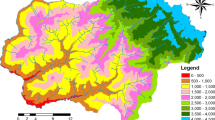Abstract
The relationship between species richness and elevation is a hot issue in ecology and has been documented extensively. It is widely accepted that area size can significantly affect this relationship and thus mask the effects of other predictors. Despite the importance of the relationship between species richness and elevation while accounting for the area effect, it is insufficiently studied. Here, we evaluated area-corrected species richness patterns of all vascular plants as well as six vascular plant subgroups (seed plants, ferns, trees, shrubs, herbs and vines) along a tropical elevational gradient (Hainan Island, China). If assessed in equal-elevation bands, uncorrected species richness showed bell-shaped curves, while area-corrected species richness assessed in equal-area bands appeared to increase monotonically due to the small proportion of highlands on Hainan Island. The mid-domain effect (MDE) was significantly correlated with both uncorrected and area-corrected species richness. On Hainan Island, the use of equal-area elevational bands increased the explanatory power of MDE. These findings provide useful insights to adjust for the area effect and highligh t the need to use equalarea bands along the elevational gradient.
Similar content being viewed by others
References
Alemdag S, Akgun A, Kaya A, et al. (2014) A large and rapid planar failure: causes, mechanism, and consequences (Mordut, Gumushane, Turkey). Arabian Journal of Geosciences 7 (3): 1205–1221. DOI: 10.1007/s12517-012-0821-1
Acharya BK, Chettri B, Vijayan L (2011) Distribution pattern of trees along an elevation gradient of Eastern Himalaya, India. Acta Oecologica 37: 329–336. DOI: 10.1016/j.actao. 2011. 03.005
Arrhenius O (1921) Species and area. Journal of Ecology 9 (1): 95–99. DOI: 10.2307/2255763
Bachman S, Baker WJ, Brummitt N, et al. (2004) Elevational gradients, area and tropical island diversity: an example from the palms of New Guinea. Ecography 27 (3): 299–310. DOI: 10.1111/j.0906-7590.2004.03759.x
Bhattarai KR, Maren IE, Subedi SC (2014) Biodiversity and invasibility: distribution patterns of invasive plant species in the Himalayas, Nepal. Journal of Mountain Science 11 (3): 688–696. DOI: 10.1007/s11629-013-2821-3
Bhattarai KR, Vetaas OR, Grytnes JA (2004) Fern species richness along a central Himalayan elevational gradient, Nepal. Journal of Biogeography 31 (3): 389–400. DOI: 10.1046/j.0305-0270.2003.01013.x
Carpenter C (2005) The environmental control of plant species density on a Himalayan elevation gradient. Journal of Biogeography 32 (6): 999–1018. DOI: 10.1111/j.1365-2699.2005.01249.x
Chen J, Ban YF, Li SN (2014) China: Open access to Earth landcover map. Nature 514: 434. DOI: 10.1038/514434c
Colwell RK (2008) RangeModel: tools for exploring and assessing geometric constraints on species richness (the middomain effect) along transects. Ecography 31 (1): 4–7. DOI: 10.1111/j.2008.0906-7590.05347.x
Colwell RK, Hurtt GC (1994) Nonbiological gradients in species richness and a spurious Rapoport effect. The American Naturalist 144 (4): 570–595. DOI: 10.1086/285695
Colwell RK, Lees DC (2000) The mid-domain effect: geometric constraints on the geography of species richness. Trends in Ecology and Evolution 15 (2): 70–76. DOI: 10.1016/S0169-5347(99)01767-X
Colwell RK, Rahbek C, Gotelli NJ (2004) The mid-domain effect and species richness patterns: what have we learned so far? The American Naturalist 163(3): E1–E23. DOI: 10.1086/382056
Connor EF, McCoy ED (1979) The statistics and biology of the species-area relationship. The American Naturalist 113: 791–833. DOI: 10.1086/283438
Grytnes JA, Vetaas OR (2002) Species richness and altitude: a comparison between null models and interpolated plant species richness along the Himalayan altitudinal gradient, Nepal. The American Naturalist 159 (3): 294–304. DOI: 10.1086/338542
Juo QF, Kelt DA, Sun ZY, et al. (2013) Global variation in elevational diversity patterns. Scientific Reports 3. DOI: 10.1038/srep03007
Janzen DH (1967) Why mountain passes are higher in the tropics. The American Naturalist 101 (919): 233–249. DOI: 10.1086/282487
Karger DN, Kluge J, Krömer T, et al. (2011) The effect of area on local and regional elevational patterns of species richness. Journal of Biogeography 38 (6): 1177–1185. DOI: 10.1111/j.1365-2699.2010.02468.x
Körner C (2007) The use of ‘altitude’ in ecological research. Trends in Ecology and Evolution 22 (11): 569–574. DOI: 10.1016/j.tree.2007.09.006
Lee CB, Chun JH (2016) Environmental drivers of patterns of plant diversity along a wide environmental gradient in Korean temperate forests. Forests 7 (1): 19. DOI: 10.3390/f7010019
Lee CB, Chun JH, Song HK, et al. (2013) Altitudinal patterns of plant species richness on the Baekdudaegan Mountains, South Korea: mid-domain effect, area, climate, and Rapoport’s rule. Ecological Research 28 (1): 67–79. DOI: 10.1007/s11284-012-1001-1
Malhi Y, Silman M, Salinas N, et al. (2010) Introduction: elevation gradients in the tropics: laboratories for ecosystem ecology and global change research. Global Change Biology 16 (12): 3171–3175. DOI: 10.1111/j.1365-2486.2010.02323.x
Marini L, Bona E, Kunin WE, et al. (2011) Exploring anthropogenic and natural processes shaping fern species richness along elevational gradients. Journal of Biogeography 38 (1): 78–88. DOI: 10.1111/j.1365-2699.2010.02376.x
McCain CM (2007) Area and mammalian elevational diversity. Ecology 88 (1): 76–86. DOI: 10.1890/0012-9658(2007)88 [76:AAMED]2.0.CO;2
McCain CM (2009) Global analysis of bird elevational diversity. Global Ecology and Biogeography 18 (3): 346–360. DOI: 10.1111/j.1466-8238.2008.00443.x
McCain CM (2010) Global analysis of reptile elevational diversity. Global Ecology and Biogeography 19 (4): 541–553. DOI: 10.1111/j.1466-8238.2010.00528.x
Nascimbene J, Marini L (2015) Epiphytic lichen diversity along elevational gradients: biological traits reveal a complex response to water and energy. Journal of Biogeography 42 (7): 1222–1232. DOI: 10.1111/jbi.12493
Nogués-Bravo D, Rodríguez J, Hortal J, et al. (2008) Climate change, humans, and the extinction of the woolly mammoth. PLOS Biology 6 (4): 0685–0692. DOI: 10.1371/journal. pbio. 0060079
Pouteau R, Bayle É, Blanchard É, et al. (2015) Accounting for the indirect area effect in stacked species distribution models to map species richness in a montane biodiversity hotspot. Diversity and Distributions 21 (11): 1329–1338. DOI: 10.1111/ddi.12374
Pouteau R, Meyer JY, Blanchard P, et al. (2016) Fern species richness and abundance are indicators of climate change on high-elevation islands: evidence from an elevational gradient on Tahiti (French Polynesia). Climatic Change: 138(1-2): 143–156. DOI: 10.1007/s10584-016-1734-x
Rahbek C (1995) The elevational gradient of species richness: a uniform pattern? Ecography 18 (2): 200–205. DOI: 10.1111/j.1600-0587.1995.tb00341.x
Rahbek C (1997) The relationship among area, elevation, and regional species richness in Neotropical birds. The American Naturalist 149 (5): 875–902. DOI: 10.1086/286028
Rahbek C (2005) The role of spatial scale and the perception of large-scale species-richness patterns. Ecology Letters 8 (2): 224–239. DOI: 10.1111/j.1461-0248.2004.00701.x Journal of Biogeography 42 (10): 1964-1974. DOI: 10.1111/jbi.12554
Van Der Wal J, Murphy HT, Lovett-Doust J (2008) Threedimensional mid-domain predictions: geometric constraints in North American amphibian, bird, mammal and tree species richness patterns. Ecography 31 (4): 435–449. DOI: 10.1111/j.0906-7590.2008.05396.x
Wang ZH, Tang ZY, Fang JY (2007) Altitudinal patterns of seed plant richness in the Gaoligong Mountains, south-east Tibet, China. Diversity and Distributions 13 (6): 845–854. DOI: 10.1111/j.1472-4642.2007.00335.x
Xing KQ, Kang MY, Wang Q, et al. (2011) Rarefaction approach to analyzing distribution patterns of species richness along altitudinal gradients: a case study with arborous species data. Biodiversity Science 19 (5): 581–588. (In Chinese) DOI: 10.3724/SP.J.1003.2011.08015
Xing FW, Zhou JS, Wang FG, et al. (2012) Inventory of plant species diversity of Hainan. Huazhong University of Science and Technology Press, Wuhan, China. (In Chinese)
Zhu Y, Jiang Y, Liu QR, et al. (2009) Elevational trends of biodiversity and plant traits do not converge—a test in the Helan Range, NW China. Plant Ecology 205 (2): 273–283. DOI: 10.1007/s11258-009-9616-1
Zhu Y, Jiang Y, Liu QR, et al. (2007) Altitudinal pattern of vascular plant species richness based on equal-area belts in Mt. Helan. Biodiversity Science 15 (4): 408–418. (In Chinese) DOI: 10.1360/biodiv.060307
Acknowledgments
We acknowledge with great appreciation the support provided by the National Special Water Programs (Grant Nos. 2009ZX07210-009, 2015ZX07203-011, 2015ZX07204-007), the Department of Environmental Protection of Shandong Province (SDHBPJ-ZB-08), the China Scholarship Council (Grant No. 201306730020), the Chinese Natural Science Foundation (Grant No. 39560023), and Queen Mary University of London.
Author information
Authors and Affiliations
Corresponding author
Additional information
http://orcid.org/0000-0002-5108-094X
http://orcid.org/0000-0001-8898-8567
http://orcid.org/0000-0001-8787-2976
http://orcid.org/0000-0002-8026-5695
http://orcid.org/0000-0002-9858-4889
Electronic supplementary material
Rights and permissions
About this article
Cite this article
Xu, X., Zhang, Hy., Luo, J. et al. Area-corrected species richness patterns of vascular plants along a tropical elevational gradient. J. Mt. Sci. 14, 694–704 (2017). https://doi.org/10.1007/s11629-016-3894-6
Received:
Revised:
Accepted:
Published:
Issue Date:
DOI: https://doi.org/10.1007/s11629-016-3894-6




